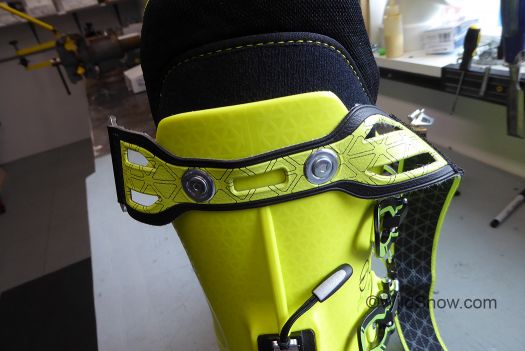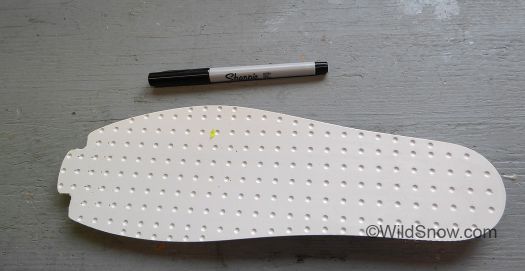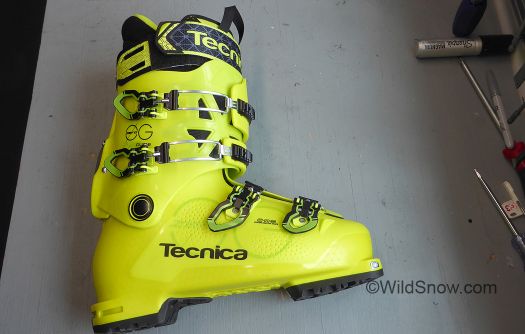
The object at hand, Tecnica Zero G Guide Pro is the lightest weight version of this boot. Options with a more alpine configured liner will presumably be available.
Let’s get something straight. Any current boot that weighs more than about 1,500 grams in size 28 is not a “ski touring” boot. Despite what PR people and gear review websites would have you believe. More, any boot that doesn’t provide more cuff mobility in walk mode than rearward to around 90 degrees is not a ski touring boot. Things in the industry have changed, fast.
Thus, we give a nod to the Zero G as a “freeride touring” boot — a quite nice one. Yet, this is not the true ski touring shoe we like to float around the mountains with when mechanized means are not involved. So, for those of you who want overlap backcountry ski boots that can double as a ski resort shoe, you know who you are. Read on.
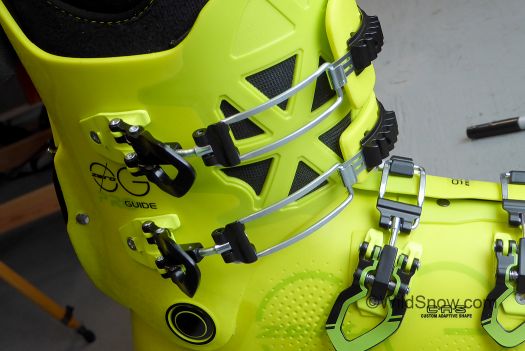
Cuff has these mesh backed cutouts that save a few grams and breath a bit, probably mostly cosmetic but why not? Note the extendo buckle bail hooks for touring mode, we always like those.
Tecnica says this boot is made with a “frame of lightweight Triax 3.0 plastic that is 2.5 times stiffer and 30% thinner than conventional boot material.” They’re probably comparing to PU, because touring boots made of Grilamid or stiff Pebax are probably about equal in weight class. Main point here is this is indeed a lightweight overlap 4-buckle boot. Pick it up in your hands and you notice the lack of mass.
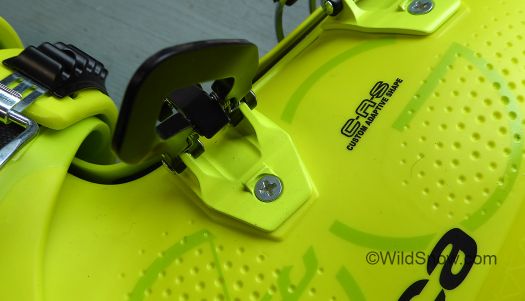
All buckles have threaded removable fasteners, still one of our favorite features and a tough thing to execute. Other companies have tried, with mixed results.
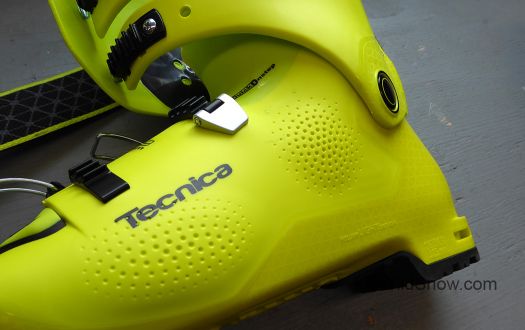
The boot is ‘pre punched’ for average foot shape, not sure what purpose the cluster of divots really serves but it probably makes punching easier.
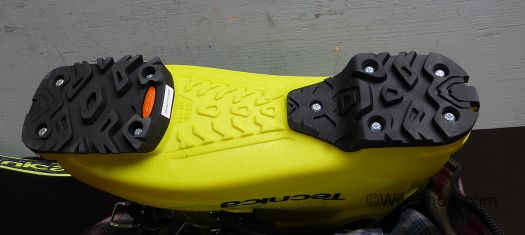
A swap sole system is there, presumably with an available set of alpine DIN sole blocks. While this boot is a bit on the soft side for a ‘beef’ boot, I’ve liked how Tecnica over the years has always tried to make boots that flex in the right places, so using Zero G as an alpine boot could be viable. I’d think you’d want a beefier liner, however.
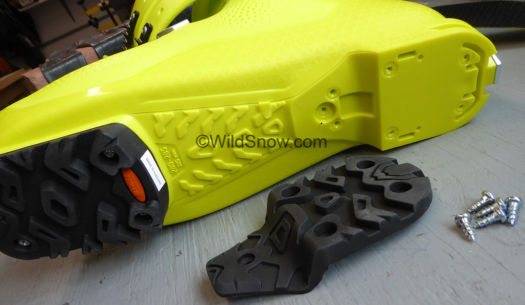
Removable sole system is clean and simple, lack of steel threaded fasteners in boot saves weight, is not a concern because force from tech bindings or alpine bindings is exerted on integral molded parts of shell not on the replaceable portion of the sole. That’s as all boot makers should configure swap soles, kudos to Tecnica for doing it right. Only concern with that, care should be taken not to strip the screw holes while swapping soles.
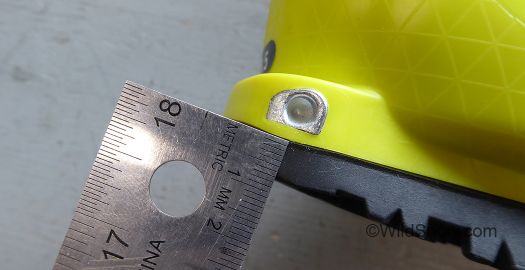
Using traditional yet still Dynafit certified tech fittings give you room for plenty of sole rubber. But sometimes too much sole rubber. See next photo.
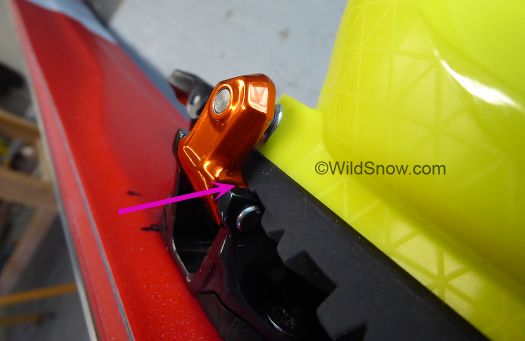
In our opinion, the sole rubber at the toe might be a millimeter or 2 too thick, easy to skive some off, but don’t forget to do so if you want you bindings working correctly.
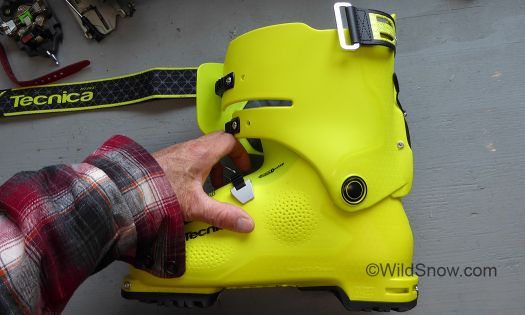
Cuff at limit of rear travel. It looks vertical but actually has a few more degrees for your leg inside, nonetheless we would like to have more travel. In fact, when Zero G is in touring mode the lean lock is totally disengaged, and it thus appears the shell could easily be modified for a few more degrees of rear travel.
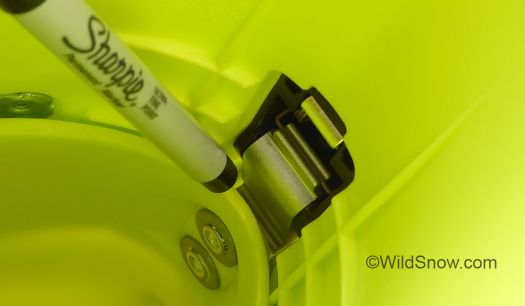
Inside view of the lean lock. They call this the “Self Adjusting System,” which confused us at first as we thought the lock might be robotic, instead “Self” just refers to you reaching down and “Adjusting” your boot between downhill and uphill modes. Jokes aside, this is a strong lean-lock with almost no play.
We did do an on-snow test of the Zero G Guide. Conclusion was that it’s not particularly stiff, perhaps a “120” to be kind, but that’s to be expected from thinner plastic and what is clearly a rather minimalist liner. If the boot was fit correctly and had beef added to the liner it would ski like it looks. Of more concern was the uphill testing. While overlap cuff boots can yield good cuff mobility, the Zero G is a bit limited. If you’re used to modern touring boots, you’ll notice a lack of rearward travel. To be fair, the lean lock on these boots is beefy, thus giving you a very solid cuff in downhill mode. We think the lean lock is why the cuff doesn’t have a few more degrees of rear travel in touring mode. So ok, a tradeoff. Carpet test a pair and decide for yourself.
Paraphrase from our main tester: “I skied a pair of the Zero G boots as a tester for a local shop. My opinions: Too heavy for real touring with no significant performance improvement that could justify the extra weight over today’s “real” ski touring boots. A quiver of one for the freeride touring crowd who can handle boots of average stiffness, and who like the feel of an overlap.”
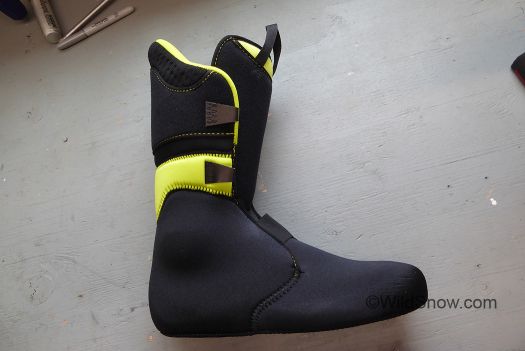
Liner is sourced from Palu, they make nice ones. Height is correct and the liner appears to actually be made specifically for this boot (not always the case in the industry).
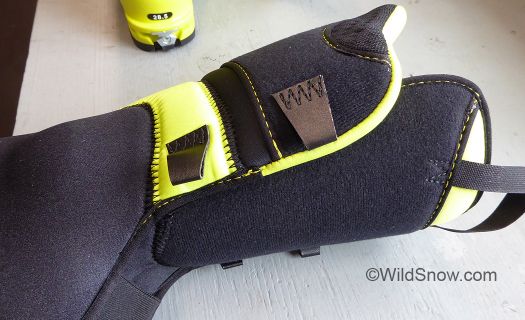
Lace anchors on the liner. Yeah, I know, only 6 people in the world use them. But those 6 people are very important.
Our 28.5 size weighs 1652 grams per boot. Compare to another freeride touring shoe that’s stiffer, in a shorter shell, that fully weighs 1996 grams yet has decent rearward cuff articulation. Significant? But which way is the significance? If you’re going to ski a big overlap cuff boot would you want some extra weight for the last word in beef? Or do you want a boot that saves noticeable weight with less stiffness and less cuff articulation? We report, you decide.
Flavors:
Zero G Guide Pro, MSRP $900
Zero G Guide, MSRP $660
Zero G Guide W (women’s specific model), MSRP $660
Note: Tecnica Cochise series boot models remain their real “beef” boot offerings.
WildSnow.com publisher emeritus and founder Lou (Louis Dawson) has a 50+ years career in climbing, backcountry skiing and ski mountaineering. He was the first person in history to ski down all 54 Colorado 14,000-foot peaks, has authored numerous books about about backcountry skiing, and has skied from the summit of Denali in Alaska, North America’s highest mountain.


